Sabal
| Palmetto | |
|---|---|
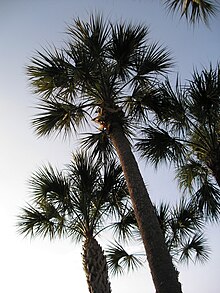
| |
| Sabal palmetto | |
| Scientific classification | |
| Kingdom: | Plantae |
| Clade: | Tracheophytes |
| Clade: | Angiosperms |
| Clade: | Monocots |
| Clade: | Commelinids |
| Order: | Arecales |
| Family: | Arecaceae |
| Subfamily: | Coryphoideae |
| Tribe: | Sabaleae |
| Genus: | Sabal Adans.[1] |
| Type species | |
| Sabal adansonii Guers.[2]
| |
| Synonyms[3] | |
| |
Sabalis a genus ofNew Worldpalms (or fan-palms). Currently, there are 17 recognized species ofSabal,including one hybrid species.[4]
Distribution
[edit]The species are native to the subtropical and tropical regions of theAmericas,from the Gulf Coast/South Atlantic states in theSoutheastern United States,south through theCaribbean,Mexico,andCentral AmericatoColombiaandVenezuela.
Description
[edit]Members of this genus are typically identified by the leaves which originate from a bare, unarmedpetiolein a fan-like structure. All members of this genus have a costa (or midrib) that extends into the leaf blade. This midrib can vary in length; and it is due to this variation that leaf blades of certain species ofSabalare strongly curved or strongly costapalmate (as inSabal palmettoandSabal etonia) or weakly curved (almost flattened), weakly costapalmate, (as inSabal minor). Like many other palms, the fruit ofSabalaredrupe,that typically change from green to black when mature.
Taxonomy
[edit]The nameSabalwas first applied to members of the group byMichel Adansonin the 18th century.[5]Previous names that this genus was associated with includeCorypha,Chamaerops,Rhapis.[6][5]This section highlights importantphylogeneticwork done within the genusSabal.
In 1990, Scott Zona outlined key morphological and anatomical characters that he used to analyze species relationships ofSabal.Through this analysis of characters, Zona produced acladogramthat portraysevolutionaryrelationships amongst 15 species ofSabal.[6]Based on the distribution of species within his cladogram, Zona recognized four distinctclades.[6]The clades within his study include (Clade 1)Sabal minor;(Clade 2)Sabal bermudana,Sabal palmetto,Sabal miamiensis,andSabal etonia;(Clade 3)Sabal maritima,Sabal domingensis,Sabal causiarum,Sabal maurittiformis,Sabal yapa,Sabal mexicana,andSabal guatemalensis;(Clade 4)Sabal uresana,Sabal rosei, andSabal pumos.[6]These clades associate closely with geographic distributions.[6]Most of the species within Clade 3 occur in theGreater Antillesand southern Mexico, where species that occur in the Greater Antilles are more closely related to each other than those that occur in southern Mexico.[6]Although Clade 4 also occurs in Mexico, these species occur on the west coast where they are geographically separated from the Mexican species within the southern part of the country.[6]The remaining two clades, Clade 1 and Clade 2 predominantly occur in the southeasternUnited StatesalthoughS. palmettoandS. minorare also known fromCubaand theBahamas(S. palmetto)and northern Mexico(S. minor).[6]Sabal bermudanais only known fromBermuda.[6]
In 2016 Heyduk, Trapnell, Barrett, and Leebens-Mack conducted a new study onSabalthat analyzed molecular (e.g. nuclear, plastid) data from 15 species of the group.[7]This study incorporatedplastidand nuclear sequence data that together were used to estimate the relatedness between the species ofSabal.[7]The results of the study show species relationships to be different from the distribution of Zona's cladogram.[6][7]Within the framework of this study, a major difference between the results of Zona and this study is the placement of "Clade 4" (Sabal uresana,Sabal rosei, andSabal pumos) which split and integrate these species throughout thephylogenyofSabal.[6][7]The largest of the clades identified by Zona, "Clade 3" is disrupted significantly as it is split into multiple clades.[6][7]AlthoughSabal causiarumandS. domingensisretain their relationship assister species,they are included in a clade that also includesS. maritimaandS. rosei.[6][7]Despite these disruptions in placement between these two studies, the overall integrity of "Clade 1" and "Clade 2" is in congruence with the clades established from the molecular data.[7][6]
Species
[edit]| Image | Scientific name | Common name | Distribution |
|---|---|---|---|
| Sabal antillensisM.P.Griff. | Antillean palmetto | Curaçao[4][8] | |
 |
Sabal bermudanaL.H.Bailey | Bermuda palmetto | Bermuda |
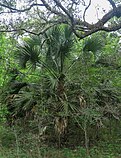
|
SabalbrazoriensisD.H.Goldman, Lockett & Read | Brazoria palmetto | United States (Texas) |
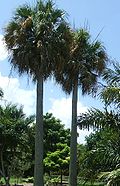 |
Sabal causiarum(O.F. Cook)Becc. | Puerto Rico palmetto | United States (Puerto Rico),British Virgin Islands,Hispaniola(Haitiand theDominican Republic) |
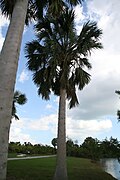 |
Sabal domingensisBecc. | Hispaniola palmetto | Cuba, Hispaniola (Dominican Republic, Haiti) |
 |
Sabal etoniaSwingleexNash | Scrub palmetto | United States (Florida) |
 |
Sabal gretheriaeH.J.Quero.R. | Yucatán palmetto | Mexico (Quintana Roo) |
| Sabal lougheedianaM.P.Griff. | Bonaire palmetto | Bonaire[8] | |
 |
Sabal maritima(Kunth)Burret | Jamaica palmetto | Jamaica,Cuba |
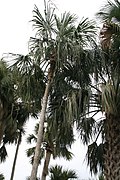 |
Sabal mauritiiformis(H.Karst.)Griseb.&H.Wendl. | Savannah palm orpalma de vaca | Southern Mexico to northern Colombia, Venezuela,Trinidad and Tobago(Trinida)) |
 |
Sabal mexicanaMart. | Mexican palmetto | United States (southern Texas) south through Mexico toNicaragua |
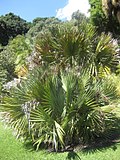 |
Sabal miamiensis | Miami palmetto | United States (Southern Florida) |
 |
Sabal minor(Jacq.)Pers. | Dwarf palmetto | Northeastern Mexico, Southeastern United States (Florida north toNorth Carolina,west to Texas) |
 |
Sabal palmetto(Walter)Lodd.ex Schult. & Schult.f. | Cabbage palmetto | Cuba, Bahamas,Turks and Caicos Islands,United States (Florida north to North Carolina) |
 |
Sabal pumos(Kunth) Burret | Royal palmetto | Mexico (Guerrero,Michoacán,Puebla) |
 |
Sabal rosei(O.F.Cook) Becc. | Rosei palmetto | Northwestern Mexico |
 |
Sabal uresanaTrel. | Sonoran palmetto | Mexico (Chihuahua,Sonora) |
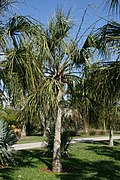 |
Sabal yapaC.Wrightex Becc. | Mexico (Yucatán Peninsula),Belize,Cuba,Guatemala[9][10] |

Prehistoric taxa
[edit]Extinct species within this genus include:[11]
- †Sabal bigbendenseManchester et al. 2010
- †Sabal bracknellense(Chandler)Mai[12]
- †Sabal grayanaBrown 1962
- †Sabal imperialisBrown 1962
- †Sabal jenkinsii(Reid& Chandler)Manchester1994[12]
- †Sabal lamanonis
- †Sabal raphipholia
Plants of the genus lived from the lateCretaceousto theQuaternaryperiod (from 66 million to 12 thousand years ago). Fossils have been found in the United States, as well as inEurope(Italy,Switzerland,Germany,Greece,Slovakia,theUnited Kingdom,France) andJapan.[11]Leaf fossils ofSabal lamanonishave been recovered fromrhyodacitetuffof LowerMioceneage in southern Slovakia near the town ofLučenec.[13]27 million year oldSabal lamanonisandSabal raphipholialeaffossilsin volcanic rocks have been described from theEvrosregion inWestern Thrace,Greece.[14]
Formerly placed inSabal
[edit]- Serenoa repens(W.Bartram)Small(asS. serrulata(Michx.) Nutt. ex Schult. & Schult.f.)[10]
Ecology
[edit]Sabalspecies are used as food sources by several species of birds (includingMimus polyglottos,Turdus migratorius,Dendroica coronata,Corvus ossifragus,andDrycopus pileatus)as well as insects, such asCaryobruchus[15]and various species ofHymenoptera.American black bears(Ursus americanus)andraccoons(Procyon lotor)are also known to feed on fruit of various species ofSabal. Sabal palmettois recorded to have its own lichen,Arthoniarubrocincta,[16]that only occurs on its leaf bases. In Europe, the introduced Lepidopteran speciesPaysandisia archonhas become a prominent pest whoselarvaeare known to feed on some of the cultivated species ofSabal.
Uses
[edit]Arborescent species are oftentransplantedfrom natural stands into urban landscapes and are rarely grown in nurseries due to slow growth. Several species are cultivated asornamental plantsand because several species are relativelycold-hardy,can be grown farther north than most other palms. The central bud ofSabalpalmettois edible and, when cooked, is known as'swamp cabbage'.Mature fronds are used as thatch, to make straw hats, and for weaving mats.
References
[edit]- ^Michel Adanson(1763).Familles des plantes.2 (in French). chez Vincent. pp.495,599.
- ^"SabalAdans ".Tropicos.Missouri Botanical Garden.Retrieved16 October2009.
- ^"SabalAdans ".Germplasm Resources Information Network.United States Department of Agriculture. 15 October 2004. Archived fromthe originalon 26 August 2009.Retrieved12 April2010.
- ^abGriffith, M. Patrick; De Freitas, John; Barros, Michelle; Noblick, Larry R. (2017)."Sabal antillensis (Arecaceae): a new palmetto species from the Leeward Antilles".Phytotaxa.303:56–64.doi:10.11646/phytotaxa.303.1.4.
- ^abRamp, Paul F.; Thien, Leonard B. (1995). "A Taxonomic History and Reexamination of Sabal minor in the Mississippi Valley".Principes.39(2): 77–83.
- ^abcdefghijklmnZona, Scott (1990)."A Monograph of Sabal (Arecaceae: Coryphoideae)".Aliso.12(4): 583–666.doi:10.5642/aliso.19901204.02.
- ^abcdefgHeyduk, Karolina; Trapnell, Dorset W.; Barrett, Craig F.; Leebens-Mack, Jim (13 May 2015)."Phylogenomic analyses of species relationships in the genus Sabal (Arecaceae) using targeted sequence capture".Biological Journal of the Linnean Society.117(1): 106–120.doi:10.1111/bij.12551.ISSN0024-4066.
- ^abGriffith, M. Patrick; Coolen, Quirijn; Barros, Michelle; Noblick, Larry R. (2019)."Sabal lougheediana(Arecaceae), a critically endangered, endemic palm species from Bonaire ".Phytotaxa.420:095–102.doi:10.11646/phytotaxa.420.2.1.S2CID208559842.
- ^"Subordinate taxa ofSabalAdans ".Tropicos.Missouri Botanical Garden.Retrieved16 October2009.
- ^ab"GRIN Species Records ofSabal".Germplasm Resources Information Network.United States Department of Agriculture. Archived fromthe originalon 24 September 2015.Retrieved7 July2010.
- ^abPaleobiology Database
- ^abManchester, Steven R. (1994)."Fruits and seeds of the Middle Eocene Nut Beds Flora, Clarno Formation, Oregon".Palaeontographica Americana.58:1–205.
- ^Vojtko, Rastislav (21 October 2016)."Miocénna flóra z lokalít Kalonda a Mučín"[Miocene flora from the localities Kalonda and Mučín].Acta Geologica Slovaca(in Slovak).1(1): 65–70.ISSN1338-0044.Archived fromthe originalon 17 October 2023.Retrieved8 July2019.
- ^Velitzelos, Dimitrios; Bouchal, Johannes M.; Denk, Thomas (2014)."Review of the Cenozoic floras and vegetation of Greece".Review of Palaeobotany and Palynology.204:56–117.Bibcode:2014RPaPa.204...56V.doi:10.1016/j.revpalbo.2014.02.006.
- ^i Monteys, Víctor Sarto; Aguilar, Lluís; Saiz-Ardanaz, Marienza; Ventura, Daniel; Martí, Mercè (June 2005). "Comparative morphology of the egg of the castniid palm borer, Paysandisia archon (Burmeister, 1880) (Lepidoptera: Castniidae)".Systematics and Biodiversity.3(2): 179–201.Bibcode:2005SyBio...3..179I.doi:10.1017/S1477200005001635.ISSN1477-2000.S2CID85748924.
- ^Grube, Martin; Lucking, Robert; Umana-Tenorio, Loengrin (September 2004). "A New Isidiate Species of Arthonia (Ascomycota: Arthoniaceae) from Costa Rica".Mycologia.96(5): 1159–1162.doi:10.2307/3762099.ISSN0027-5514.JSTOR3762099.PMID21148936.
External links
[edit]- Sabalimagesat Fairchild Tropical Botanical Gardens
- Sabalat Scanpalm

